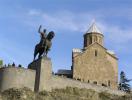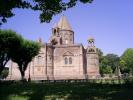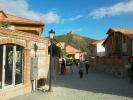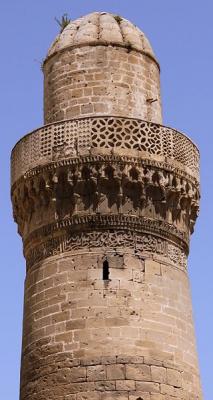|
|
||
|
|
||
|
|
||





Azerbaijan-Georgia-Armenia
13 days/12 nights Azerbaijan part Day 1 Arrival in Baku Meeting at the Airport. Transfer to the hotel. Baku city tour Places to visit: Icheri Sheher- known as Inner city. It is the historical core of Baku; UNESCO Heritage: Palace of the Shirvanshahs - the biggest monument of the Shirvan-Absheron branch of the Azerbaijan architecture; Mulberry Tree Square (for a long period of time, an explicit symbol of the Old City was a mulberry tree located behind the Djuma Mosque. It was believed that the tree was several hundred years old. The tree made its way into many sayings and songs popular in the Old City, and became a local landmark. The place where that tree was located was referred to as Mulberry Tree Square.) Maiden Tower - is noted landmark and one of Azerbaijan's most distinctive national emblems; Gobustan Rock Art Cultural Landscape – It covers three areas of a plateau of rocky boulders rising out of the semi-desert of central Azerbaijan, with an outstanding collection of more than 6,000 rock engravings bearing testimony to 40,000 years of rock art. Overnight in Baku. Day 2 Museum of History Currently the museum has 6 departments The total number of museum values greater than 300 000 items. 20 000 of them exhibited at the exposition, the rest is kept in scientific storage facilities – numismatic (over 150, 000), archaeological (93 000), ethnography (9000), arms (2300), scientific archive (12 000), precious metals fund (15 000 ), negatives (10 000), fund of rare books (4570). The museum publishes a collection of articles entitled "Materials on the history of Azerbaijan." Azerbaijan State Museum of Carpet The first museum in the world of carpets. Opened in 1972. In the museum there are works of art from different regions of Azerbaijan (Gabai, Guba, Shirvan, Ganja, Gazakh, Tabriz, etc.), carpets and subjects related to arts and crafts, Hauli (halcha, challah, challah will, Kaba) hovsuz (carpet, kshim, Shadd, Varna, Zilya, chechim, sumac), a variety of rugs (chul, mafrash, heyba, hurchun, ehar gashlygy.) also demonstrated museum exhibits related to the ancient period, the black ceramic and bronze objects produced in the 19., artistic embroidery, fabric, glass, metal, wood and jewelry, weapons and other artifacts. Overnight in Baku. Day 3 Baku – Shemakha - Sheki Drive to Shamakha - is a city and the capital of the Shamakhi Rayon of Azerbaijan. The city has a rich heritage and has provided the backdrop to major political events throughout much of its two millennia of existence. Then drive to Sheki. On the way we will stop in Maraza to visit the Diri Baba mausoleum and visit Seven Tombs and Friday mosque in Shemakha. Arrival to Sheki, visiting Local history museum, local applied arts museum and Shebeke craft centre and showroom. At the end of the tour transfer to the hotel and check in. Overnight in Sheki. Day 4 Sheki - Lagodekhi - Telavi Walk through the Sheki bazaar (market) and look at the various local handicrafts including scarves, unique boxes, a plethora of sweets, confections and local sweet bakery. Then we will visit to Palace of Sheki Khans (XVIII A.D.) where is the most outstanding and valuable monument of the 18th century Azerbaijan. Transfer to the Georgian border - Sadakhlo Georgian part Ariving to Telavi- the main city and administrative center of Georgia’s eastern province of Kakheti. Overnight in Telavi Day 5 Telavi State Museum – Sighnaghi – Tbilisi Visit Telavi State Museum colmplex includes the memorial place of the Kakhetian King Erekle II, a court church, a philosophy school, a bath and tunnel built by Erekle II. Drive to Sighnaghi - one of the beautiful towns of the kakheti region. Sighnaghi and its environs are home to several historical and cultural monuments. The town is walled with the remnants of 18th century fortifications. At the elevation of about 790 m above sea level, the town overlooks the Alazani valley and faces the Greater Caucasus Mountains. Drive to Tbilisi. Overnight in Tbilisi. Day 6 Tbilsi city tour Tbilisi (literally "Warm Spring") is the capital and the largest city of Georgia, lying on the banks of the Mt'k'vari River. Founded in the 5th century by Vakhtang Gorgasali, the Georgian King of Iberia, and made into a capital in the 6th century, Tbilisi is a significant industrial, social and cultural centre. Located strategically at the crossroads between Europe and Asia and lying along the historic Silk Road routes, Tbilisi has often been a point of contention between various rival powers and empires. The history of the city can be seen by its architecture. Places to visit: Old town: Metechi church and the statue of king Vakhtang Gorgasali (founder of Tbilisi -5th century); Abanotubani – is the ancient district of Tbilisi, known for its sulfuric baths; Narikala fortress; Sharden street, Synagogue, Sioni Cathedral, Anchiskhati Basilica – is the oldest surviving church in Tbilisi (6th century), The Holy Trinity Cathedral, commonly known as Sameba is the main Georgian Orthodox Cathedral and it is listed among the largest Orthodox churches in the world. Shota Rustaveli Avenue; Open Air Museum of Ethnography – it is essentially a historic village populated by buildings moved there from all main territorial subdivisions of Georgia. Day 7 Ananuri-kazbegi-Tbilisi Drive to Ananuri. Visit Ananuri (17th century) is a castle complex on the Aragvi River. Tour along hiostorical Georgian Military Road. Continue the tour to kazbegi by crossing the “Jvari Pass” (2379 m. above the sea level) . Explore the area – the beautifully situated on the hill. Hire 4X4 vehicles to get to Gergeti Holy Trinity Church is a remarkable monument of Georgian architecture, near the village of Gergeti, situated at an elevation of 2170 meters, under Mount Kazbegi (elevation 5033). Drive back to Tbilisi. Overnight in Tbilisi. Day 8 Mtskheta-Gori-Uplistsikhe-Tbilisi Drive to Mtskheta - one of the oldest cities of the country of Georgia, was capital of the early Georgian kingdom of Iberia during the 3rd century BC - 5th century AD and it was the site of early Christian activity. Visit Svetitskhoveli Cathedral (11th century) and Jvari Monastery (6th century) in Mtskheta are among the most significant monuments of Georgia architecture, and are historically significant in the development of medieval architecture throughout the Caucasus. Drive to Gori. The city was founded by one of the greatest kings of Georgia – David the Buider (1089-1125). Gori is also known as the birthplace of the Soviet leader Joseph Stalin. Visit Joseph Stalin state museum. Drive to Uplistsikhe (literally, “the lord's fortress”) is an ancient rock-hewn in eastern Georgia. Built on a high rocky left bank of the Mtkvari River, it contains various structures dating from the Early Iron Ages to the Late Middle Ages, and is notable for the unique combination of various styles of rock-cut cultures from Anatolia and Iran as well as the co-existence of pagan and Christian architecture. Drive back to Tbilisi. Overnight in Tbilisi. Day 9 Tbilisi - Lake Sevan- Yerevan 8:00 Departure to Armenia. (visa can be received in Armenia border) Armenian part Lake Sevan – pearl of Armenia, is the largest lake in Armenia and one of the largest high-altitude lakes in the world, situated in the central part of Armenia. Arriving to Yerevan. Yerevan is the capital and largest city of Armenia and one of the world's oldest continuosly0inhabited cities. Situated along the Hrazdan River. Yerevan is the administrative, cultural, and industrial center of the country. Sightseeing: Republic Square (small copy of the Square in Vatican), Yerevan Opera Ballet Theatre, Kaskad and others streets in the central part of Yerevan. Overnight in Yerevan Day 10 Garni-Geghard Drive to Garni - is a temple complex located in the Kotyak Province of Armenia. The first traces of human occupation date back to the 3rd millennium BC. In the 8th century BC the area was conquered by the Urartian king Argishti I. The first literary testimony to the existence of a fortress on the spur crowning the site of Garni comes from the Roman historian Tacitus and dates from the middle of the 1st century AD. The particular interest is the bathhouse located in the northern part of the site. Drive to Geghard Monastery is a unique architectural construction in the Kotayk province of Armenia, being partially carved out of the adjacent mountain, surrounded by cliffs. (13th century) It is listed as a Unesco World heritage Site. Drive back to Yerevan. Visiting Matenadaran Matenadaran is an ancient manuscript repository located in Yerevan. It holds one of the world's richest depositories of medieval manuscripts and books which span a broad range of subjects, including history, philosophy, medicine, literature, art history and cosmography in Armenian and many other languages. Overnight in Yerevan Day 11 Etchmiadzin- Zvartnots – “Ararat” Drive to Etchmiadzin. Etchmiadzin Cathedral – is the head quarters and official residence of the Catholics of all Armenians. The Etchmiadzin Cathedral is the oldest state-built church in the world (4th century), the same period when Armenia adopted Christianity as official religion. Visiting the church of St.Hripsime (7th century) which is a short distance away from the cathedral. Drive to Zvartnots. Zvartnots Cathedral - are the ruins of a seventh century centrally-planned aisled tetraconch type Armenian cathedral built by order of the Catholicos Nerses the Builder (7th century) Drive back to Yerevan. Visiting Armenian Brandy Factory-“Ararat” Overnight in Yerevan Day 12 Khorvirap-Noravank Drive to Khor Virap - is an Armenian Apostolic Church monastery (17th century), located in the ararat plains, vine yards and faces to Mount Ararat. The monastery had a theological seminary and was the residence of Armenian Catolicos. On the way to Noravank it is possible to have wine degustation in Areni. Noravank is a 13th century monastery, located 122 km from Yerevan in a narrow gorge made by the Darichay river, nearby Yeghegnadzor city. The gorge is known for its tall, sheer, brick – red cliffs, directly across from the monastery. Noravank was founded in 1205. Drive back to Yerevan. Diner at the restaurant with folk show. Day 13 Departure. Transfer to the Yerevan International Airport. |
||











